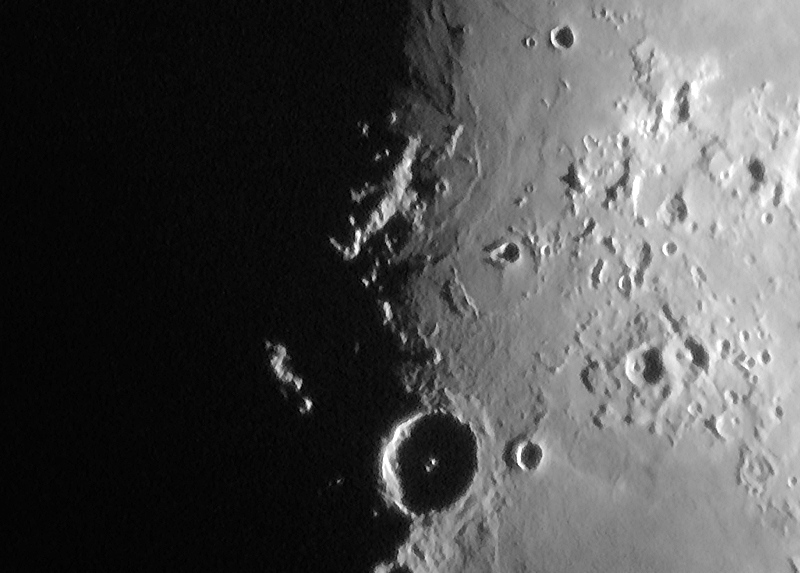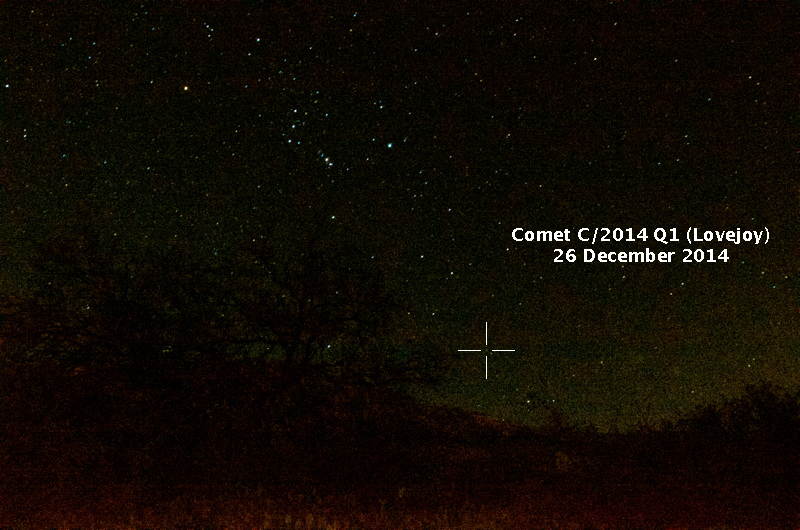iPhone Lunar Imaging,
D7000 DSLR Comet C/2014 Q2 (Lovejoy)
Posted: 27 December 2014
Cloudy nights returned 24 and 25 December 2014, with some rain (0.08") on Christmas Night. The sky cleared on Friday, 26 December. I went out to the observatory mid-day and wiped off some rain water, both liquid and frozen (overnight temp was 31°F), from the dome.
|
Open: Friday, 26 December 2014, 1816 MST Temperature: 42°F |
Session: 758 Conditions: Clear |
1825 MST: viewed Venus, just above the western horizon (and through some trees), 83X. It appeared as a rainbow of colors due to atmospheric refraction. Next, viewed Mars, 83X; no details seen.
Then viewed the moon, 83X. Took this handheld iPhone 5s afocal 83X photograph:

Switched to the William Optics Binoviewers, 100X, and did some lunar observing. A 3D effect was most noticeable on the northern terminator. Added the 1.6X Barlow Lens (for 160X) and did some lunar touring, including on the Earthlit side. The views were awesome. Two areas in particular were fascinating and I took photographs of them using the iPhone 5s, handheld, afocal 160X. This is Mare Serenitatis showing a nice curving mountain range as well as the large crater Posidonius (cropped from the full-frame image):

The other fascinating area was the structure just north of the crater Theophilus, both of which are seen in this cropped iPhone afocal 160X image:

Removed the Barlow Lens and did some more lunar observing with the Binoviewers.
1939 MST: slewed to M42 (Great Nebula in Orion) and viewed it just rising above a tree using the Binoviewers, 100X. Switched to the Meade 2" 24mm UWA eyepiece (83X) and began waiting for Comet C/2014 Q2 (Lovejoy) to rise above the hill to the southeast. Temperature was now 33°F.
1952-2013 MST: short "warm up" break. When I returned to the observatory the temperature was down to 31°F. Glad I had hot chocolate in the observatory!
Comet Lovejoy was now visible in the 8" LX200-ACF telescope, 83X. The coma was large and bright but no tail was visible. The comet was still very low in the southeast. It was easily seen in my Celestron Cometron 12x70 binoculars. It was not (yet) visible to the naked eye; the bright moonlit sky didn't help. At 2031 MST, took this handheld D7000 DSLR sky photograph, 30 seconds, ISO 6400, showing where Comet Lovejoy was located below the constellation of Orion. (I messed up and didn't notice until post-processing that the camera lens was set at f/22 and not f/3.5. Argh!)

2046 MST: began preparing for imaging of the comet with the 8" telescope. Added a f/6.3 focal reducer and mounted the D7000 DSLR at prime focus using the Meade Off-Axis Guider. The comet was easily seen in the camera viewfinder. Began waiting for the comet to rise higher in the sky.
2105 MST: Comet C/2014 Q2 (Lovejoy) was now visible to the naked eye as a faint fuzzy patch. The bright moonlit sky was still a factor.
2107-2126 MST: another "warm up" break. Temperature was now 30°F.
Did a focus test on the star Rigel using the Spike-a Bahtinov Mask and then slewed back to Comet Lovejoy. After waiting a few more minutes for it to rise higher, I began imaging the comet at 2149 MST using 1 minute, ISO 5000, exposures. The comet's tail was visible in these short exposures, allowing me to slew the telescope for proper framing to show both the coma and tail.
This is Comet C/2014 Q2 (Lovejoy), unguided, 2 minutes, ISO 5000, showing its tail streaming towards the lower left corner:

2216 MST: ended comet imaging. Removed the camera and focal reducer. 2228 MST: took last look at the comet, 83X. The tail was now faintly visible in the eyepiece.
2230 MST: viewed Jupiter, low in the eastern sky, 83X. The four Galilean Moons were visible.
|
Close: Friday, 26 December 2014, 2240 MST Temperature: 30°F |
|
NOTE: As the Reports page file size was getting rather large, I have moved the Past Reports listing to their own web page. Click on the "Past Reports" link on the main Reports page to view past reports.
I have updated the "Terms and Conditions of Use" web page for the "Cassiopeia Observatory" web site. Previously it had the same "Terms and Conditions of Use" as for "Weasner's Mighty ETX Site". Since my ETX Site is no longer being updated, it seemed advisable to have "Terms and Conditions of Use" specific to my "Cassiopeia Observatory" web site.
Comments are welcome using Email. If you are on Twitter you can use the button below to tweet this report to your followers. Thanks.
Cassiopeia Observatory Home Page
Copyright ©2014 Michael L. Weasner / mweasner@me.com
URL = http://www.weasner.com/co/Reports/2014/12/27/index.html
